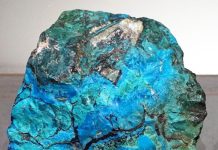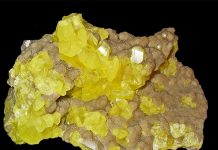
Calcite crystals at rock shops and dealers at gem and mineral shows have recently been large volumes of inexpensive, massive calcite from Mexico. In both rough and fabricated forms, this calcite has a soft translucency and comes in pleasing shades of red, orange, yellow and white. Most distinctive, however, especially in rough pieces, is its smooth, lustrous, glassy surface, which still retains many of its original, irregular projections and concavities. Although this undulating surface may seem to be the product of mechanical polishing, it is actually created by a much faster, cheaper, and less labor-intensive method—brief immersion in acid.
A Simple Carbonate
Calcite, or calcium carbonate (CaCo3), crystallizes in the trigonal system. It occurs in many crystal habits, of which the most familiar is well-developed rhombohedrons. With a specific gravity of 2.7 to 3.0, calcite is only slightly denser than quartz.
As a simple carbonate, the calcite molecule consists of a divalent calcium cation bound to a negatively charged (anionic) carbonate radical. The weak ionic bonding between the calcium ions and the carbonate radical explains many of calcite’s physical properties, including its relative softness of Mohs 3.0 and its tendency to cleave easily into rhombohedrons.
Weak Ionic Bonding
Weak ionic bonding also explains another of calcite’s diagnostic properties: its vigorous effervescence in acids. The term “effervescence” refers to a foaming or “boiling” effect caused by the release of millions of tiny gas bubbles. Effervescence was a traditional demonstration in high-school chemistry classes; instructors would mix an acid and a carbonate compound, usually sodium bicarbonate (baking soda), to produce the violent foaming that is the principle behind soda-acid fire extinguishers.
That same reaction occurs when acid contacts calcite. Using hydrochloric acid (HCl) as an example, calcite effervesces vigorously when the acid’s highly reactive chlorine ions (Cl1-) break its weak ionic bonds and replace its carbonate radicals.
This reaction is stated by the formula CaCO3 + 2HCl = CaCl2 (calcium chloride) + H2O (water) + CO2 (carbon dioxide). The rapid release of carbon dioxide gas creates the bubbles of effervescence. Mineral-effervescence tests are usually performed with cold, dilute hydrochloric acid. Effervescence is apparent when just a single drop of this acid contacts a calcite surface.
Calcite Crystals & Acid-Effervescence
While all carbonate minerals will eventually dissolve in dilute hydrochloric acid, only a few effervesce vigorously. The action of cold, dilute hydrochloric acid on dolomite (calcium magnesium carbonate) generates only a subtle effervescence. This is because closer atomic packing within dolomite’s orthorhombic crystal lattice strengthens the ionic bonds between the calcium and magnesium cations and the carbonate anions, making dolomite much less susceptible than calcite to the chemical action of acids.
Interestingly, acid-effervescence does not occur at all in aragonite, the orthorhombic polymorph of calcium carbonate. Although aragonite and calcite crystals have identical chemistries, aragonite’s orthorhombic crystal structure has a much stronger ionic bonding that resists the action of acids.
Massive Calcite Crystals From Mexico
In the massive calcite now mined in Mexico, the red and orange shades are caused by tiny, included particles of hematite (iron oxide) in various sizes. The smallest particles are believed to produce red, while larger particles create orange and yellow.
Many of these Mexican calcite crystals are fashioned into cups, ashtrays, paperweights, figurines, and other decorative objects. Some, in pieces as large as 1 or 2 feet high, are kept in their rough shape to serve as home or office display pieces.
After the calcite crystals are roughly fabricated or sized, this material is briefly immersed in acid to dissolve a thin layer of the calcite, leaving a smooth, lustrous, glassy surface. By greatly reducing the scattering of incident light, this surface improves translucency and intensifies the internal colors. Acid immersion also eliminates or makes smooth any remaining saw or wheel marks on fabricated pieces.
Quick and inexpensive, acid immersion improves both the appearance and marketability of all that colorful Mexican calcite—thanks to that mineral’s diagnostic tendency to readily effervesce in acid.
This article about calcite crystals and acid effervescence previously appeared in Rock & Gem magazine. Story by Steve Voynick. Click here to subscribe.














